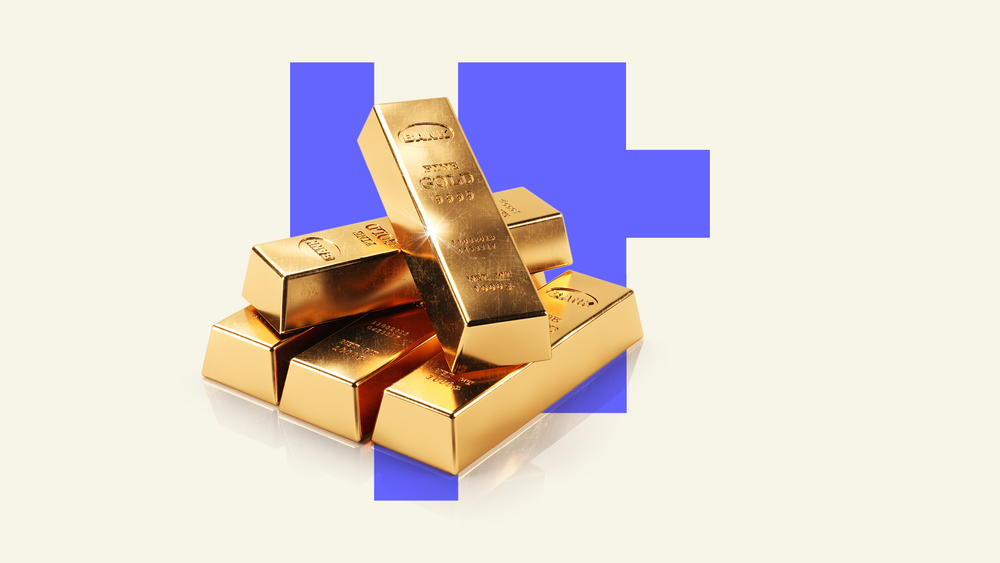When and why a gold ETF can shine in a portfolio
In recent years, gold has been thoroughly in the spotlight. As the world lurches from crisis to crisis - pandemic and war and soaring inflation - the precious metal has significant appeal as a store of value. When the rest of the markets collapse, gold tends to rise, suggesting it merits an important spot in investors’ portfolios.

Why use a gold ETF?
Gold ETFs are a great way to get access to the gold price in a cheap and liquid way, without having to actually buy a gold bar and store it under the floorboards! Investing in gold is attractive to many as a 'safe haven' when traditional stock markets are falling. We saw this during the height of the Covid pandemic, when the price of gold soared to record highs while markets were tumbling.
There are a number of ways you can access gold through a gold ETF. Some buy gold 'bullion' (basically the actual gold bars themselves), some use derivatives to directly track the live price, and others invest in gold mining companies.
Like all ETFs, gold ETFs are traded on an exchange and bought or sold like a normal share on the stock market, meaning they cost relatively little to own and you can buy in with relatively small amounts. But remember, investing in a gold ETF doesn't mean you'll actually get the precious metal in any form - instead, you get the cash equivalent.
What are the different types of gold ETF?
There are three main types of gold ETF. Here's a breakdown:
Gold Mining ETFs - The most popular type of gold ETF, these include a basket of shares from gold mining companies. ETFs based on gold mining companies won't track the gold price exactly. The share price performance for these companies will have a relationship with the spot price (the exact current value of an asset at a given point), but will also depend on other elements, such as the skill of the management team or labour and materials costs.
ETCs - Short for 'Exchange-Traded Commodity', this type of gold ETF tracks the price of gold by buying physical gold bullion. Naturally, these ETFs track the price of gold exactly.
Derivative Gold ETFs - And finally, these ETFs use derivatives to replicate the price of gold without buying real gold bars. Derivatives-based ETFs use gold futures to replicate the performance of the gold price. These may deviate from the price of real gold because of differences between the spot price of gold and futures prices.
Which type of gold ETF is better?
For an investor who wants pure exposure to the gold price, but doesn’t fancy sourcing and owning gold bars themselves, a physically-backed gold ETC is likely to be the best option. The Invesco Physical Gold ETC is a popular choice, for example. This one has a low management fee (0.12%) as you're not paying for a portfolio manager to make ongoing decisions about your investments, adheres to the London Bullion Market Association (LBMA) Responsible Gold Guidance in compliance with the highest ethical standards (more on this later), and is billions of dollars in size.
There will be points in the economic cycle when buying shares in gold mining ETFs will likely be the most profitable option. For example, when stock markets are down in the dumps, you might make more money buying gold mining shares because they get exposure to the gold price plus the rising tide of stock markets. However - as is always the case with investing - remember that this can work in reverse when markets are falling!
Derivative gold ETFs based on gold futures are still a popular option, but these may not track the gold price as closely and will have some counterparty risk because of the derivatives exposure. Best for more experienced investors or those comfortable with a greater degree of risk.
When should investors use gold?
Investors often see gold as providing protection within a portfolio. Usually, when the chips are down, gold is a good option. It’s the asset to hold during periods of war, pandemics, and economic crisis, which is why it's been performing so well over the past few years.
However, there are times when gold may not be a great option. From August 2020 to March 2021, the price of gold dropped from over $2,000 per ounce to under $1,700, as it became clear that the advent of vaccines would bring the pandemic to an end and investors crept back to traditional markets. When times are good, no-one's really interested in gold, and this can see the price drop - sometimes quite significantly.
So, a lot of factors can influence the gold price and predicting its direction can be complex. One common factor, however, is the strength of the US dollar; Investors often turn to gold when the dollar is falling. Interest rates and inflation are also important.
A lot of claims have been made for gold as an inflation hedge. There have been periods in history when gold has performed well during times of high inflation, but there's actually a greater relationship with interest rates.
For example, although gold rose to near record-highs in March 2022 after Russia's invasion of Ukraine, the precious metal actually plunged in the face of spiraling inflation rates. In recent weeks, its price has risen again in response to reports of stabling US inflation and reports that US interest rate hikes will taper.
Is gold a responsible investment?
There are, however, serious and often overlooked environmental and ethical costs to mining gold. At a time when investors are more aware of the environmental impact of their investments than ever, the ethics of gold trading has been drawing attention from regulators and consumers alike.
Of course, there's the consideration that the act of gold mining is, in itself, a hugely controversial process. It has a significant environmental impact, with the company Earthworks reporting that the manufacture of a single gold wedding ring costs an estimated 20 tonnes of waste.
There has also been a long history of slave labour and unethical working conditions attached to the gold mining industry, such as in Ghana, where Human Rights Watch reported in 2015 that the mines 'offer important income opportunities for Ghana’s rural populations, but also encourage hazardous child labor and cause serious environmental damage'.
Many of the world's biggest gold ETCs have been focusing on purchasing bars made since 2012, when the LBMA introduced its Responsible Gold Guidance, which aims to 'combat systematic or widespread abuses of human rights, to avoid contributing to conflict, comply with high standards of anti-money laundering and combating terrorist financing practice'.
However, due to how older gold bars are often recycled and incorporated into new ones, many gold bars made in the years after 2012 may contain gold whose history is unverifiable. In fact, LBMA research states that more than half of gold manufactured by mainstream refineries is recycled, and there's no way of distinguishing how much of the new bars are made up of old gold.
Though recycled gold evidently has less environmental impact than newly-mined metal, there's still a risk that it may have been previously manufactured under unethical labour conditions, or even been traded as part of illegal operations.
The gold mining industry is starting to adapt, however, particularly in regard to meeting higher standards of sustainability. There's now a credible pathway for the gold mining industry to decarbonise and reach net zero by 2050. In 2019, the World Gold Council launched the Responsible Gold Mining Principles to set a framework for what should be considered 'responsible' gold mining.
Top performing gold ETFs/ETCs
The gold ETFs/ETCs with the highest returns in 2022 were:
Xtrackers IE Physical Gold ETC Securities [XGDU] | 12.63%
iShares Physical Gold ETC [SGLN] | 12.62%
Xtrackers Physical Gold ETC (EUR) [OXA5] | 12.55%
Source: justETF. Data correct as at 01/01/23.
More on sustainable investing
You can read more about investing with ESG ETFs here.
And if you're interested in sustainable and ESG investing, make sure to pop over to our Sustainable Investing Hub to read more, watch videos, take quizzes and learn where to start!



